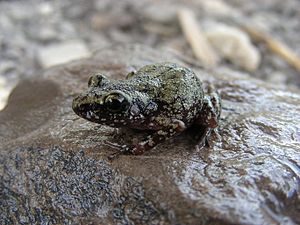Eleutherodactylus pipilans facts for kids
Quick facts for kids Eleutherodactylus pipilans |
|
|---|---|
 |
|
| Conservation status | |
| Scientific classification | |
| Genus: |
Eleutherodactylus
|
| Species: |
pipilans
|
| Synonyms | |
|
Syrrhophus pipilans Taylor, 1940 |
|
The Eleutherodactylus pipilans is a small frog that belongs to the family Eleutherodactylidae. People often call it the whistling chirping frog. This interesting amphibian lives in parts of southern and southeastern Mexico. You can also find it in southwestern Guatemala.
Contents
Meet the Whistling Chirping Frog
This frog is known for its unique calls. It is a type of "rain frog," which means it does not need water to lay its eggs. Instead, its eggs develop directly into tiny froglets. This makes it special among frogs.
What Does This Frog Look Like?
Adult male whistling chirping frogs are about 23 to 29 millimeters long. That's less than an inch and a half! Female frogs are a similar size, from 21 to 29 millimeters. Their skin on their back can be smooth or a bit bumpy.
They have pretty big eyes. You can also see their eardrum, called a tympanum, which is oval shaped. Their arms are long, but their legs are quite short.
Colors and Patterns
The main color of these frogs is usually dark brown or a lighter brown. But they often have cool blotches or spots! These spots can be yellow, orange, light brown, or even greenish. Their legs also have bands of color. Male frogs have special vocal slits. These help them make their whistling or chirping sounds.
Where Do These Frogs Live?
The whistling chirping frog makes its home in tropical forests. These forests have wet and dry seasons. They live in areas that are 100 to 800 meters above sea level. That's like living on a small mountain!
Finding a Home
These frogs are not picky about where they rest. You can find them in many different spots. They might be sitting on rocks or on the ground. Sometimes, they hide under rocks or other fallen things. They have even been found living inside caves!
Protecting the Whistling Chirping Frog
Even though you can find many of these frogs in some places, they still face dangers. Their biggest threat is habitat loss. This happens when their forest homes are cut down or changed.
It's important to protect these forests. This helps make sure the whistling chirping frog has a safe place to live. Protecting their habitat helps many other animals too!
See also
 In Spanish: Eleutherodactylus pipilans para niños
In Spanish: Eleutherodactylus pipilans para niños


